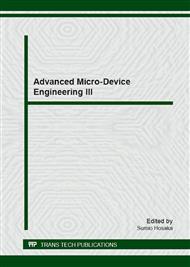p.220
p.227
p.233
p.241
p.247
p.251
p.257
p.262
p.267
Vapor-Liquid-Solid Growth of Silicon-Based Nanowires for High Sensitive Sensor
Abstract:
Silicon-based nanowires (Si-NWs) were fabricated by vapor liquid solid (VLS) growth, and Si-NW device was prototyped using focused ion beam (FIB) processing. The needle shaped thin Si-NWs were formed at a substrate temperature between 1120 and 1313°C. The average and minimum diameters of the NWs were confirmed 60 nm and 44 nm, respectively. As the double-layered structure was observed in the NWs by transmission electron microscope images, it is possible that those are silicon-based NWs with Si core and SiO2 shell structure. From current-voltage characteristics, the Si-NW device has a semiconducting property, and the estimated resistivity of the Si-NW is about 3.1 x 104 Ωcm.
Info:
Periodical:
Pages:
257-261
Citation:
Online since:
January 2013
Authors:
Price:
Сopyright:
© 2013 Trans Tech Publications Ltd. All Rights Reserved
Share:
Citation:


